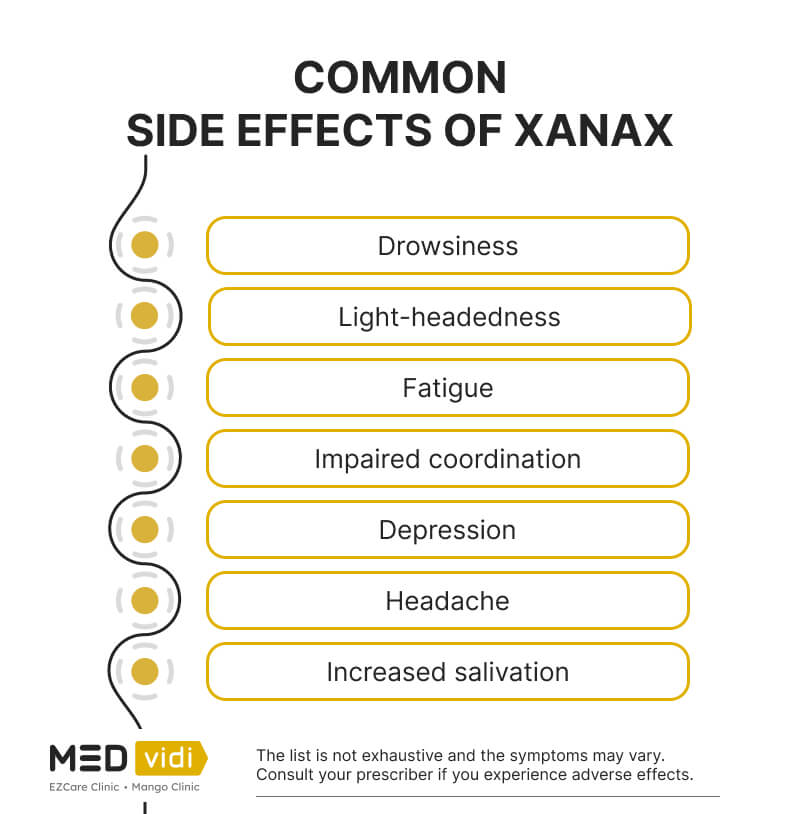Anxiety disorders affect approximately
This blog post takes a closer look at Xanax, exploring its potential side effects and the various aspects to consider. Read on to gain insights into the main features of this medication and learn more about the points you might want to discuss with your prescriber before starting treatment.
Our highly qualified healthcare professionals are ready to provide you with the support you need.
Xanax vs. Xanax XR
The half-life of these formulations differs too. It takes approximately 11.2 hours for half of Xanax’s active ingredients to leave the body. On the other hand, Xanax XR has a notably longer elimination half-life of around 15.8 hours. As a result of these differences, Xanax is suitable for managing both anxiety and panic disorders, while Xanax XR is primarily used in the treatment of panic disorder.
Due to its relatively short duration of action, Xanax is often administered up to three times daily to maintain consistent therapeutic levels in the body. In contrast, Xanax XR is usually taken just once a day, providing sustained relief throughout the day. Note that these recommendations may differ depending on different factors, so it’s essential to consult your healthcare provider to know how to take the prescribed medication.
Common Side Effects of Xanax
Xanax has a range of potential side effects, from common and less severe to serious. Not everyone will experience these, but it’s important to be aware of them so you can report any that you may encounter. The side effects can vary depending on whether Xanax is prescribed for anxiety disorders or panic disorders as dosages can vary for these conditions. A higher dosage usually carries a higher risk of side effects. The maximum daily recommended dosage of Xanax for anxiety and panic disorder is 4 mg and 10 mg, respectively.
Individuals using Xanax to treat anxiety disorders at lower dosages may experience:
- Drowsiness
- Light-headedness
- Dry mouth
- Low blood pressure
- Increased salivation
- Skin allergy
When Xanax is taken to address panic disorder at higher dosages,
- Drowsiness
- Fatigue
- Impaired coordination
- Irritability
- Memory loss
- Changes in appetite and weight
- Cognitive issues
- Constipation
- Dysarthria
- Skin allergy
- Confusional state
- Change in libido
- Increased salivation
Mild Side Effects of Xanax
Mild side effects are relatively common, a missed dose can occasionally cause them as well. These include:
- Irritability
- Trouble concentrating
- Loss of coordination
- Sedation
- Slurred speech
- Muscle twitching
- Menstrual irregularities
- Urinary retention
These side effects might not require medical attention unless they become severe or persistent. However, tell your doctor if you experience any unusual or bothersome symptoms.
Severe Side Effects
Serious side effects of Xanax demand immediate medical attention. These are as follows:
- Memory impairment
- Allergic reactions
- Seizures
- Hallucination
- Manic behavior
- Impaired motor coordination
- Mood changes
- Risk of withdrawal and dependence
- Difficulty driving or using heavy machinery
Xanax Warnings
Xanax is classified as a
Liver Function
Your liver is where many drugs are metabolized. Some drugs start off inactive and only become active after the liver processes them. These active forms are what produce the drug’s intended therapeutic effect.
Xanax (alprazolam) is one of the drugs that undergo this process in the liver. If the liver isn’t working properly, it takes a long time for the body to remove Xanax, which can be about 20 hours. So, people with
Additionally, some
Contact us today to schedule an online appointment and receive personalized anxiety treatment.

Substance Use Disorder
Substance use disorder occurs when an individual repeatedly uses substances like drugs or alcohol in high doses for an extended time, which harms their health and daily life. Xanax (alprazolam) belongs to a class of drugs called benzodiazepines, which are known for their potential for misuse and abuse. It should only be used under the guidance of a healthcare professional because it can cause substance use disorder if taken without a prescription or inappropriately.
Misusing benzodiazepines often involves taking more than the recommended dose and combining them with other drugs, alcohol, or illegal substances. This significantly raises the risk of serious problems like breathing problems, overdose, or death. Therefore, healthcare professionals screen and evaluate patients for substance misuse and a history of substance abuse before prescribing Xanax. People with drug abuse are also at an increased risk of experiencing withdrawal symptoms.
If you or someone you know is struggling with substance use disorder, including Xanax abuse or any other substance, it’s crucial to seek help from a healthcare provider or addiction specialist.
Impact on Older Adults
Xanax affects
Among the side effects of alprazolam observed in older adults, heightened sedation, increased drowsiness, impaired coordination, and memory problems stand out. These effects can pose significant risks, including a greater likelihood of falls and related injuries.
In light of these considerations, healthcare professionals often exercise caution when prescribing Xanax to older patients, opting for lower doses and closely monitoring for adverse effects. Adjusting the dosage based on individual responses becomes a critical strategy in ensuring the medication’s safety and effectiveness for older adults.
Pregnancy and Breastfeeding
Alprazolam is categorized as pregnancy class D by the United States Food and Drug Administration (FDA), indicating potential risks to the fetus.
Effects of Xanax Withdrawal
Xanax is prescribed for short-term treatment because when used for an extended period, it can make you both physically and psychologically dependent. When you take higher doses or use it for a longer duration, it carries a risk of
- Abnormal involuntary movements
- Dizziness
- Anxiety
- Depression
- Insomnia
- Blurred vision
- Derealization
- Seizures
- Fatigue
- Gastrointestinal disturbances
- Headache
- Irritability
- Memory impairment
- Muscle ache
Xanax withdrawal can be uncomfortable and, in certain instances, may lead to life-threatening withdrawal symptoms.
Rebound Effects
Rebound effects happen when the symptoms a medication is supposed to help with come back or get worse after you stop taking the medication. Rebound effects typically vary depending on the reason you were taking it. In the case of Xanax, these may be heightened or rebound anxiety, worsening of insomnia, and the return of panic attacks.
Rebound effects are common in benzodiazepine withdrawal because these medications calm anxiety and help with sleep. But when you stop taking them, your brain can react by making these issues worse. Always talk to your healthcare professional before trying to stop Xanax or change how you take it.
Tapering Off Xanax
To reduce rebound effects and manage Xanax withdrawal safely, it’s important to lower the dose gradually under a provider’s supervision. Tapering off helps your body and brain to adjust slowly, minimizing the intensity of withdrawal symptoms. The specific tapering schedule and duration can vary depending on individual factors, including the dosage, duration of Xanax use, and the presence of any underlying medical or psychological conditions.
Your healthcare provider will assess your current Xanax usage and health to create a personalized tapering plan. During this plan, your doctor will closely monitor your progress, offer psychological support for potential anxiety, explore alternative treatments if needed, and ensure continued care after completing the tapering process.
Effects of Xanax Overdose
Xanax overdose occurs when the medication is taken at levels exceeding the recommended maximum dosage, leading to a variety of potentially life-threatening medical symptoms and complications. Some effects of overdosing are as follows:
- Severe drowsiness
- Respiratory depression
- Confusion
- Impaired coordination
- Diminished reflexes
- Coma
- Death
If there is suspicion of a Xanax overdose, seek immediate medical attention. Trained medical professionals can administer the antidote for benzodiazepine
Xanax Interactions With Other Drugs
Mixing Xanax with other prescription medications, over-the-counter drugs, and recreational substances can be risky and cause unpredictable health effects. Their interactions can either enhance or diminish the effects of each medication, potentially resulting in harmful consequences.
Combining Xanax with other CNS depressants, like alcohol, opioids, specific sleep medications, or other benzodiazepines, can increase sedating effects. This can result in respiratory depression, severe drowsiness, impaired coordination, confusion, and a higher chance of accidents and injuries. It also greatly increases the risk of overdose. Mixing Xanax with stimulant drugs can place significant stress on the cardiovascular system, raising the likelihood of heart issues such as arrhythmias and elevated blood pressure.
Using Xanax with other drugs can- also heighten the risk of developing psychological and physical dependence on multiple substances and worsen the potential for addiction. Always tell your healthcare provider about all the medications you use. They can provide guidance on safe drug interactions and help you avoid potentially harmful combinations.
Xanax Addiction and Treatment
Xanax addiction treatment should be individualized to meet the unique needs of each person and typically follows the following structured process:
- A healthcare professional or addiction specialist conducts a thorough medical assessment to understand the extent of Xanax use and check for any other health issues.
- A controlled detox process is done in case of physical dependence, slowly reducing Xanax to ease withdrawal symptoms.
- Behavioral therapy, like cognitive-behavioral therapy (CBT), is also employed.
- In some cases, medication may be used as part of the treatment plan.
- Comprehensive care and relapse prevention strategies are implemented, such as learning coping skills.
- A healthcare professional might also encourage joining support groups for a valuable network of people with similar experiences.
Long-term follow-up and support are often needed for lasting recovery from Xanax addiction.
Conclusion
Having a comprehensive understanding of Xanax’s potential side effects is essential for individuals either contemplating or already utilizing this medication. Xanax can lead to a spectrum of common side effects, and it’s vital to remain vigilant for more severe adverse reactions. While Xanax can offer vital relief for anxiety and panic disorders, its usage demands a cautious approach under the expert guidance of a healthcare professional.
FAQ
What should you avoid while taking alprazolam?
While using alprazolam, it’s important to avoid drinking alcohol, grapefruit juice, and taking drugs that depress the central nervous system, such as opioids, sedative-hypnotics like sleeping pills, and muscle relaxants. Patients should be attentive during activities that demand mental alertness like driving or operating heavy machinery, avoid combining Xanax with other medications to prevent interaction, and never change the dosage or abruptly stop Xanax without the guidance of a healthcare professional.
Is alprazolam a high-risk medication?
Yes, alprazolam is indeed considered a high-risk medication. It is generally not recommended for long-term use due to several factors, including its known potential for dependence and addiction, the discomfort and challenge of managing withdrawal symptoms, the development of tolerance with prolonged use, its sedative effects, and the potential for drug interactions.
Who should avoid Xanax?
Xanax should only be used under the guidance and prescription of a healthcare provider. Several groups might need increased caution before using it. These include pregnant or nursing women, individuals with a history of substance abuse, older adults who are more sensitive to Xanax effects, people with certain medical conditions (respiratory issues, liver disease, or depression), and those taking certain medications (antidepressants, antihistamines, or opioids). Additionally, caution is advised for individuals allergic to Xanax or its components and those with a history of dependence on benzodiazepines.
Do the side effects of Xanax go away?
The side effects of Xanax, like many medications, can vary from person to person. Some side effects, such as drowsiness or dizziness, may go away relatively quickly as the body adjusts to the medication. Others, like cognitive impairment or changes in mood, may persist as long as the medication is being taken. If you are experiencing bothersome side effects from Xanax or have concerns about its duration, it is crucial to consult your healthcare professional.
What does Xanax do for women?
Xanax’s effects are not gender-specific; it works similarly for both men and women. It is effective in alleviating symptoms of anxiety and reducing the intensity of panic attacks. Additionally, it can aid in promoting sleep. Xanax should be taken only under the guidance and prescription of a healthcare provider.













